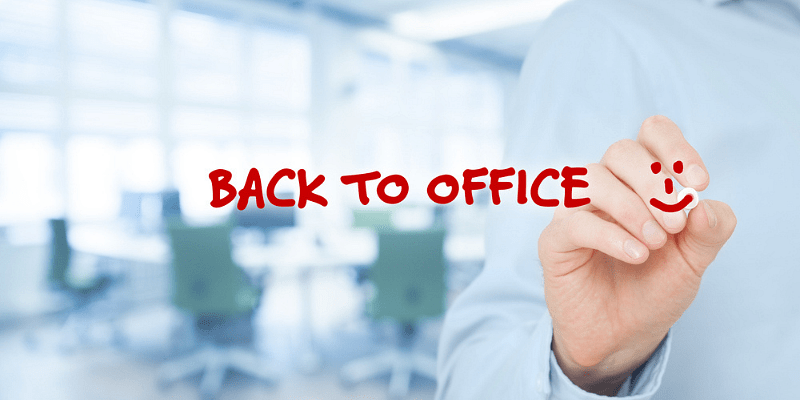![]()
People have never been this excited to go to the office, and the reason for this excitement stems from the fact that a considerable number of the workforce hasn’t stepped into the office for over a year.
The slogan ringing across every organisation is ‘let’s go back’. But going back isn’t that simple. Even though everyone desires to be back, it will require a carefully planned transition to a new normal where safety and security is still the number one priority.
To ease the transition back to the workplace, HR will have to adapt to the changes brought on by the pandemic. They will need to make new policies, modify the physical workplace, and anticipate and remove foreseeable hurdles. The HRs have a task at hand, unlike any other in recent history, and here are four steps they need to take before calling employees back to the office:
1. Proper communication and circulation of information
Take accurate polls and surveys to understand your employees’ motivations to get back in the office. It is essential to ensure that the reasoning behind resuming normal operations is communicated to each and every employee.
Understand their thoughts, gather their opinions, and consider their feedback while drafting a plan for their needs and the needs of your organisation as a whole. You can distribute your communications regarding office reopening electronically, in writing, and at video meetings. But be sure that your message is consistent across all these channels.
Be systematic and strategic while maintaining transparency. Ensure that any and all information regarding the reopening is drafted adequately in documents, and the same is provided to employees many days in advance.
Once employees start coming back to the office, create an editorial calendar with regular dates for communicating regular updates with your employees, whether it’s my newsletter, email, or a scheduled meeting. Keep all lines of communications open and ensure that your employees are in sync with the company’s expectations.
2. Ensuring a seamless transition back to the office
Safety and security should be your priority before you bring the workforce back into the office. Ensure that robust security precautions like sanitisation chambers, temperature scanners, workplace disinfection, PPE kits, and informational posters are in place.
Instead of opening the doors to your office, bring your employees back in stages. Fewer people in the office will allow you a seamless transition and give you time to test out the new policies and routine, and promote social interaction. The criteria of selection can be either as per requirement or through any of the following:
• First name
• Birth month
• Department
• Seniority
• Volunteer
3. Make employees feel safe and supported
The pandemic hasn’t just run riot with the healthcare systems across the world but has severely impacted people’s mental and physical health. The pandemic has triggered a wave of mental health issues. HR teams across the board should be aware of the drastic effects of self-isolation and working remotely on their employees.
Good mental healthat work and good management go hand in hand, and HR teams will have to ensure that they keep track of employee stress and anxiety. Also, incorporate mental health leave into your paid time-off policies. Lastly, gather mental health resources and share them across your organisation.
4. Update policies and procedures to match the new normal
The pandemic has brought a wind of change worldwide, from the personal to the professional; every part of life has seen a drastic transformation, and it has forever changed the way every industry does business. HR teams need to learn from these transformations and formulate policies and procedures accordingly.
HR departments need to adopt a comprehensive people-first strategy and implement policies designed to keep employees safe and informed, quell fears, and limit disruptions to operations across all departments.
HR teams need to tap into the trends that have emerged throughout the pandemic and be a vector of change for the workplace. They need to take a deep look at contemporary procedures and modify them to allow employees to safely do their job in an environment that provides a sense of normalcy.
We are providing practical training (Labor Laws, Payroll, Salary Structure, PF-ESI Challan) and Labor Codes, Payroll Consultant Service & more:
- HR Generalist Practical Training: https://oneclik.in/hr-generalist-practical-training/
- Labor Law + Payroll-Practical-Training: https://oneclik.in/labor-law-payroll-practical-training-certificate/ (PF, ESI, Bonus, Payroll & more)
- Labor Code, 2020 (Crash Course): https://oneclik.in/labor-code2020-rules-practical-training-certificate-crash-course/
- Labour Code | Labour Bill (Labour-Law-Practical-Training): https://oneclik.in/labour-law-practical-training/ (Factory, Contact Labor, Maternity Act & more)
- PF – ESI Consultant Service: https://oneclik.in/pf-esi-consultant-service/
- Labor Law, Compliance & HR – Payroll Management
- Advance Excel Practical Training: https://oneclik.in/advanced-excel-practical-training-certificate/
Get Latest HR, IR, Labor Law Updates, Case Studies & Regular Updates: (Join us on Social Media)
- Telegram Channel: “One Clik”
- Whatsapp Group: https://wa.me/919033016939
- Facebook: One Clik
- Linkedin: One Clik
- Instagram: oneclik_hr_management
- YouTube: One Clik

